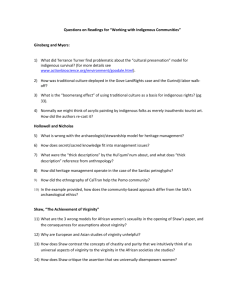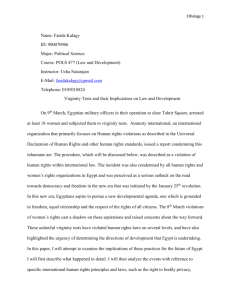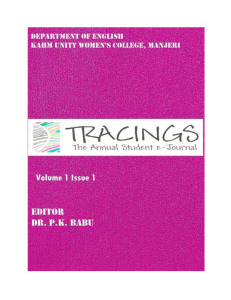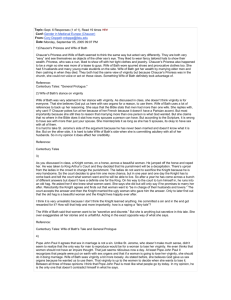COMMISSION ON GENDER EQUALITY
advertisement
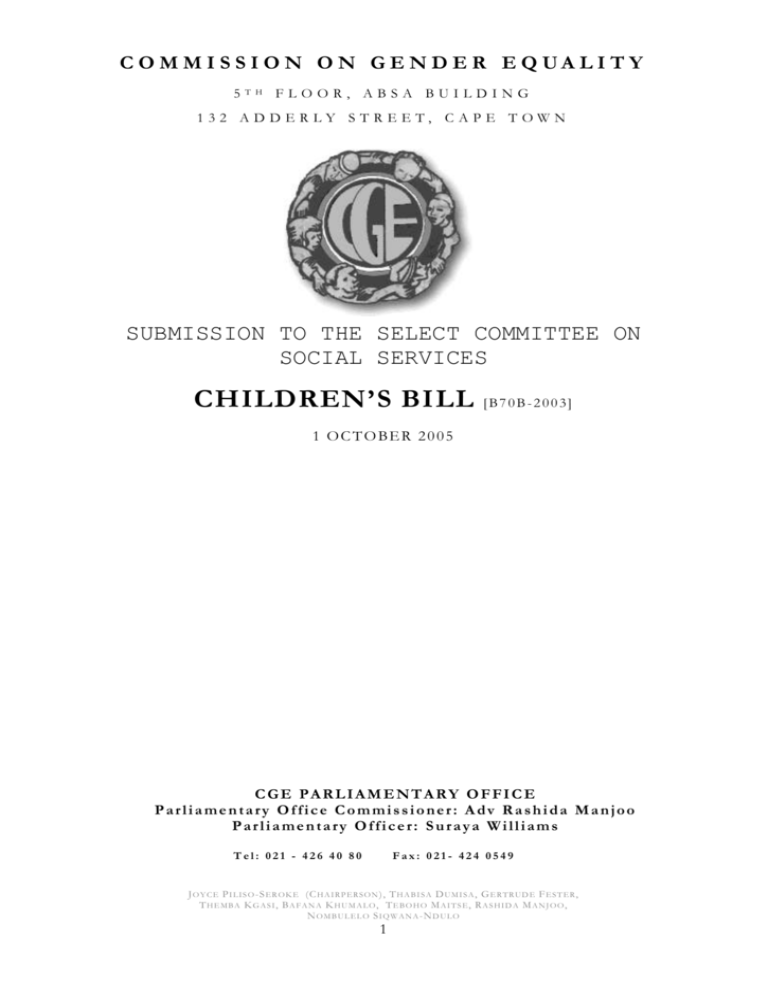
C O M M I S S I O N O N G E N D E R E Q UA L I T Y 5 T H FLOOR, ABSA BUILDING 132 ADDERLY STREET, CAPE TOWN SUBMISSION TO THE SELECT COMMITTEE ON SOCIAL SERVICES CHILDREN’S BILL [B70B-2003] 1 OCTOBER 2005 CGE PARLIAMENTARY OFFICE Parliamentary Office Commissioner: Adv Rashida Manjoo Parliamentary Officer: Suraya Williams SURAYA WILLIAMS Tel: 021 - 426 40 80 Fax: 021- 424 0549 J O Y C E P I L I S O -S E R O K E (C H A I R P E R S O N ), T H A B I S A D U M I S A , G E R T R U D E F E S T E R , THEMBA KGASI, BA FANA KHUMALO, TEBOHO MAITSE, RASHID A MANJOO, N O M B U L E L O S I Q W A N A -N D U L O 1 INTRODUCTION The Commission on Gender Equality (CGE)1 is an independent statutory body, established in terms of Section 187, Chapter 92 of the Constitution of South Africa, Act 108 of 1996. Our mandate is to promote respect for gender equality and the protection, development and attainment of gender equality. The powers and functions of the CGE are detailed in the Commission on Gender Equality Act 39 of 1996. In terms of Section 11(1), the CGE must inter-alia evaluate any law proposed by Parliament, affecting or likely to affect gender equality or the status of women, and make recommendations to Parliament with regards thereto. Section 7(2) of the Constitution compels the state to fulfil the rights stipulated in the Bill of Rights. Sections 9, 10; 11, 12, 14, 27 and 28 of the Constitution3 permits the State to the enact legislation promoting, equality, human dignity, life, freedom and security of the person, privacy, and access to health care in South Africa. The law of general application limits all these rights, to the extent that they are reasonable and justifiable in an open democratic society based on human dignity4. The Children’s Bill has recently been finalised by the Parliamentary Portfolio Committee on Social Development, and approved by the National Assembly. The Children’s Bill aims at consolidating the laws relating to the welfare and protection of children, which gives effect to the Constitutional Bill of Rights, now awaits the approval of the NCOP. This objective, acknowledges Section 28 of the Constitution, which provides for the rights of children. The CGE would like to commend Parliament, the Department on Social Development, and Civil Society for their active engagement and robust debate, which intern ensured a constitutionally sound piece of legislation. We would like to acknowledge that many of the revised provisions of the Children’s Bill are credited to the spirited advocacy initiatives by civil society. 1 Hereinafter referred to as the CGE Constitution of South Africa, Act 108 of 1996. 3 Constitution of South Africa, Act 108 of 1996. 4 S36(1) Act 108 of 1996. J O Y C E P I L I S O -S E R O K E (C H A I R P E R S O N ), T H A B I S A D U M I S A , G E R T R U D E F E S T E R , THEMBA KGASI, BA FANA KHUMALO, TEBOHO MAITSE, RASHID A MANJOO, N O M B U L E L O S I Q W A N A -N D U L O 2 2 The CGE commends the Portfolio Committee on Social Development for the Children’s Bill5, as it aims at consolidating the laws relating to the welfare and protection of children. This objective, acknowledges Section 25 of the Constitution, which provides for the rights of children. CGE COMMITMENT TO DATE: To promote and protect gender equality, the CGE has robustly campaigned for the criminalisation of harmful social, cultural and religious practices, which includes virginity testing. On the 12 June 2000, the CGE initiated a conference on Virginity Testing, which was co-hosted with the South African Human Rights Commission. To take this process further, the CGE has made written and oral submissions to Government and Parliament at the various stages of the finalisation of the Bill. Prior to the tabling of the Children’s Bill in Parliament, the Department of Social Development consulted with the CGE on the provisions relating to the health aspects in the Children’s Bill. The CGE made a written submission to the Department of Social Development on the Draft Children’s Bill pertaining to circumcision, virginity testing, and female genital mutilation. On the 10 August 2004, the CGE Parliamentary Office participated in the Public Hearings, and submitted a written and oral presentation to the Portfolio Committee on Social Development. Our submission focused on issues relating to virginity testing, circumcision, and female genital mutilation. On the 12 April 2005, the Portfolio Committee on Social Development hosted a workshop to obtain clarity on difficult policy issues relating to the Children’s Bill. The CGE submitted a written submission on the legal and social arguments around virginity testing, and female genital mutilation, as well as issues which are considered to be harmful cultural practices with regard to the Children’s Bill. Since the tabling of the Bill in Parliament, the CGE has continued with lobbying and advocacy. We acknowledge that issues relating to children, are broadly covered by the South African Human Rights Commission, and in light hereof, our submission will focus on the following issues, which are of primary concern to the Commission in respect of girl children: 1. Introduction 2. Constitutional Perspective 3. Virginity Testing 5 Hereafter referred to as the Bill 3 4. Female Genital Mutilation CONSTI TUTIO N AL PERSP ECTIVE SECTION 28 Children’s rights are entrenched in the Bill of Rights, which clearly states that the best interests of every child should be of paramount importance in every matter concerning the child. This therefore includes the child’s right and respect to bodily integrity, which includes issues around virginity testing, and health care. The State is committed to gender equality, as evident from the Constitution. Sexual, social and cultural responsibilities are disproportionately borne by women and the girl-child. Section 28 provides that children should be free from violence, coercion, discrimination, intimidation and abuse as this is essential in achieving gender equality. Section 28(1)(d) explicitly states that all that children must be protected from maltreatment, neglect, abuse or degradation. SECTION 12 of the Constitution provides for freedom and security of the person, which includes the right to bodily and physical integrity. SECTION 14 of the Constitution states that everyone has the right to privacy. Virginity testing as a practice, infringes these rights in the following respects: Virginity testing of children without their informed consent, is an invasion of bodily and physical integrity, and an invasion of privacy. The question still remains whether children can give informed consent, under the guise of culture. The reality of issues such as coercion, parental compulsion, duress, as well as social pressures needs to be acknowledged. Disclosing the girl child’s virginity status to someone else, without their consent is an invasion of privacy. The previous Bill6 which provided for virginity testing of children7, failed to protect the children in respect of the aforesaid rights, as it did not provide for non-disclosure of 6 B70-2003 Harmful social and cultural practices 12. (1) Every child has the right not to be subjected to harmful social and cultural practices that affect the well-being, health or dignity of the child. (2) Every child— 7 4 the virginity testing results to someone else. Children should be protected against the disclosure of their virginity status to someone else. SECTION 36 of the Constitution provides for the limitation of rights in the Bill of Rights. In considering less restrictive means, Parliament is entitled to have regard not only to constitutional rights, but also considerations of cost, practical implementation, and the prioritisation of certain social demands8. Alongside the issue of less restrictive means, is the extent of the infringement, and the strength of the justification. The level of justification required to warrant a limitation upon a right depends on the extent of the limitation. The more invasive the infringement, the more powerful the justification must be.9 The following three key issues need to be considered in evaluating the validity of the limitation. The practice of virginity testing without consent of the child, as a prerequirement is an infringement of the rights of the child. Disclosing the results of the virginity testing, to someone else, is a more significant invasion. The only safeguard the previous Bill10 had, was that it made provision for children to refuse to be subjected to virginity testing. Secondly, we need to consider how powerful the justification for the infringement will be. The justification is to the benefit of the “culture”, or an attempt to address the HIV/AIDS pandemic. Currently, the claim of virginity testing as a culture is still a contested issue. The accuracy of the results is unreliable, as the hymen can be severed for reasons other than sexual penetration. Finally, we need to consider if there are less restrictive means to combat the HIV/AIDS pandemic. The CGE is of the opinion that there are other less restrictive (a) below the minimum age set by law for a valid marriage has the right not to be given out in marriage or engagement; and (b) above that minimum age has the right not to be given out in marriage or engagement without his or her consent. (3) Female genital mutilation or the circumcision of female children as a cultural practice is prohibited. (4) Taking into consideration the child’s age, maturity and stage of development, every male child has the right— (a) to refuse circumcision; and (b) not to be subjected to unhygienic circumcision. (5) Every child has the right— (a) to refuse to be subjected to virginity testing, including virginity testing as part of a cultural practice; and (b) not to be subjected to unhygienic virginity testing. 8 S v Manamela and Another at [34] S v Manamela and Another 10 The Bill as tabled in Parliament: [B70A-2003] 9 5 means to address the HIV/AIDS pandemic, such as educating, and empowering children to make informed choices with regard to their sexuality. SECTION 39 of the Constitution provides that the Bill of Rights should be interpreted in a manner which “promotes the values which underlie an open and democratic society based on human dignity, equality and freedom”. The preamble of the Constitution, speaks of the need to “heal the divisions of the past and establish a society based on democratic values, social justice and fundamental human rights. It invites South Africans to actively engage with the values and rights enshrined in the Constitution, to build a new democratic society, and to “improve the quality of life of all citizens” and to “free the potential of all persons”. Virginity testing for children will fail to heal the gender inequalities of the past, and will make the vulnerable girl child, even more vulnerable. The Bill [B70B-2003] has been amended to, which now provides that “Every child has the right not to be subjected to social, cultural and religious practices which are detrimental to their well-being.” To give effect to this constitutional objective, virginity testing for girls has now been prohibited. EQU ALI TY PERSPECTIVE The Promotion of Equality and the Prevention of Unfair Discrimination Act No.4 of 2000, gives effect to Section 9 of the Constitution, which aims at preventing and prohibiting unfair discrimination, as well as to promote equality, and eliminate unfair discrimination. Section 8 of this Act, prohibits unfair discrimination on the grounds of gender. Section 8(d) prohibits any practice, including traditional, customary or religious practice, which impairs the dignity of women, and undermines equality between women and men, including the undermining of the dignity and well-being of the girl child. "In African culture, a man who deflowers a virgin pays damages to the girl's parents," Makoni explains. "At the same time, if a man marries a virgin he pays the parents an extra cow, called 'chimanda'. If a young woman is not a virgin she is considered to have less value. 6 This often leads to her being abused by her husband,” “Makoni focuses on girls because, he says, girls can be 'controlled'. Once they are controlled, he says, they have "the keys" to prevent pre-marital sex. “11 Virginity testing, clearly discriminates on the grounds of gender and impairs on the dignity and well-being of the girl child. The provision of virginity testing clearly disregards the dignity and well being of the girl child, as the harm that it causes the girl child, clearly outweighs the intended benefits. Virginity testing subjects, and exposes vulnerable girl children, to an invasion of their privacy, degrading treatment, impairs their dignity, stigmatisation, sexual abuse, and even diseases such as HIV/AIDS. The certificate awarding ceremonies for the virgins, which only honors girls who pass the virginity test as chaste individuals, creates the fear of isolation and stigmatization for the young girls who were not awarded certificates. This clearly discriminates against girls, as their male counterparts are free to do what they wish, while the girls are saddled with the responsibility of ensuring their hymen remains intact. We have noted the claim that virginity testing is not only restricted to the girl child. From our consultative conference on virginity testing, it has emerged that the intensity of this practice, and the test itself, is not the same for the boy child as it is for the girl child. Due to the fact that virginity testing is mostly practiced on girl children, clearly discriminates, and undermines girl children. CL AUSE 12 12: VIRGINI TY TESTING 11 Virginity Testing to beat Aids, Inter Press Service: 18 February 2004 Social, cultural and religious practices 12. (1) Every child has the right not to be subjected to social, cultural and religious practices which are detrimental to his or her well-being. (2) Every child— (a) below the minimum age set by law for a valid marriage has the right not to be given out in marriage or engagement; and (b) above that minimum age has the right not to be given out in marriage or engagement without his or her consent. (3) Genital mutilation or the circumcision of female children is prohibited. (4) Virginity testing of children is prohibited. (5) Taking into consideration the child’s age, maturity and stage of development, every male child has the right to refuse circumcision. (6) (a) A person who contravenes subsection (3) or (4) or who permits such contravention in respect of a child whom he or she is obliged to protect against maltreatment, abuse or degradation is guilty of an offence. (b)Aperson who circumcises a male child against his will or a person who is obliged to protect a male child against maltreatment, abuse or degradation and who allows that child to be circumcised against his will is guilty of an offence. 12 7 The practice of virginity testing has become the latest trend, and has increased in recent years. This is seen in some societies as a method of combating the HIV/AIDS pandemic. Virginity testing is done to determine if the girls’ hymen is in tact. The hymen is the thin skin that stretches across part of the virginal opening, which has an opening that allows the menstrual flow to pass out from the body. It is common knowledge, and has been proved that not all girls are born with hymen, that the hymen can be stretched open by the use of tampons, and that it can also be ruptured as a result of exercise, as well as physical and sporting activities. The following provisions with regarding virginity testing were of great concern to the Commission: No penalties are stipulated for non compliance with hygienic virginity testing; No procedure is stipulated in respect of virginity testing; Virginity Testing is an invasion of the Constitutional right to Privacy & Bodily integrity; The previous draft of the Bill: Clause 1213 provided for virginity testing by default; The Bill did not provide for confidentiality in respect of the results of the virginity testing; Virginity testing is disproportionate in respect of gender. CULTURE: The CGE supports the Constitutional Rights entrenched in Section 31 of the Constitution, which provides for the freedom of cultural practices, only in so far as it is consistent with the Constitutional principles of equality. It is difficult to say whether virginity testing could still be regarded as part of culture. Upon close examination, the revival of this practice was a reaction to social ills, of which HIV/AIDS was paramount. If a practice was revived, the claims were usually made that it was for cultural purposes. The idea that virginity testing was cultural, had to be challenged for a number of reasons. This practice contravenes the Bill of Rights, as it was biased against girl children. More girls than boys are subjected to virginity 13 Clause 12 of the Bill [B70A-2003], dealt with harmful social and cultural practices, which provided for virginity testing. No consent from the child was required to be subjected to virginity testing. This clause however gives children the right to refuse to be subjected to virginity testing. Clause 12(5)(b) of the Bill [B70A-2003] stated that every child has the right not to be subjected to virginity testing. 8 testing, even though the results are inconclusive, and unreliable, as other events besides penetration could tear a girl’s hymen.14 The revival of discriminatory practices in the name of Culture, undermines the Constitutional Bill of Rights. GENDER INEQUALITIES: Virginity testing disproportionately affects women and the girl children. The marking of these women, make this vulnerable group, even more vulnerable, as they are now exposed to a greater risk of rape, and other forms of abuse. Virgins have also become a commodity in the trade of child trafficking. ‘The revival of old-style local practices to address a modern global pandemic such as HIV/AIDS, will do more harm than good, as long as marked gender inequalities, sexual violence and hegemonic, masculine sexualities are left unchallenged.’15 Sexual offences are highly gendered, and they are a cause of disempowerment and inequality. Dealing effectively with them, and their consequences, is important for achieving gender equality. The primary victims of sexual offences are women. The media has also highlighted the alarming increase in rape and other sexual offences against babies and girl children. Virginity testing exposes victims of sexual crimes, and on the other hand, the marking of virgins does not afford protection to girl children against sexual crimes. Victims of sexual offences are known to suffer abandonment, rejection and violence, on disclosing their identity. The practice of virginity testing will in all likelihood further victimise the girl child victims of sexual offences, who are themselves already suffering from the consequences and trauma of offence. It is against this backdrop that the practice of virginity testing should be analysed, especially in respect of its implications for the girl child. HYGIENE: There has been shocking reports of virginity testing, which include women being examined unhygienically, and women who stuff meat and lace into their virginals, to fool the testers16. Virginity testing is generally conducted in public areas, such as community Halls, schools, and sports fields. HIV/AIDS: The CGE however does not support virginity testing as an answer the HIV/AIDS pandemic, as there are other non-intrusive ways of addressing the issues Professor Charles Dlamini “The Constitution and the Practice of Cultures” in the CGE Report on the Consultative Conference on Virginity Testing, 2000, page 37 14 Suzanne Leclerc-Madlala quoted in article by Amita Parashar “Where Angels Fear to Tread” Mail & Guardian, 6-12 August, page 37 16 Mail & Guardian; 6-12 August 2004; page 37 15 9 of HIV/AIDS. The gender power imbalances needs to be addressed, and this could be through a comprehensive education campaign around issues of sexuality. FEM ALE GENI TAL MUTIL ATION The CGE supports Clause 12(3)17 of this Bill, which outlaws female genital mutilation, and female circumcision as a cultural practice. We feel that this is important, and support the inclusion of this Clause in the Bill, especially since there has not been any medical support for this practice to date. The CGE feels that this clause may to some extent seek to give effect to the standards stipulated in Clause 8. CONCLUSION We believe that this Bill will assist in defining the rights and responsibilities of children, as well as to consolidate the laws relating to the welfare and protection of children. It is not possible to lay down an absolute standard or test for justification of an infringement of rights. One has to apply these principles, and weigh all these factors together. In doing so, leads to the conclusion that virginity testing, will fail to meet the requirements of Section 36 of the Constitution. Virginity testing, even as a cultural practice violates a number of the rights guaranteed in our Bill of Rights, as well as international instruments ratified by South Africa. In conclusion, the CGE does not support the practice of virginity testing. At the same time, we do recognise the importance of the rights of individuals to practise their culture, but emphasise that this should be in accordance with the Constitution. The Children’s Bill does not outlaw virginity testing as a practice, but merely seeks to protect children from this practice, by prohibiting virginity testing in respect of children only. 17 12 (3) Genital mutilation or the circumcision of female children is prohibited. 10
